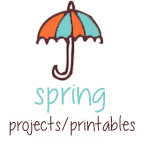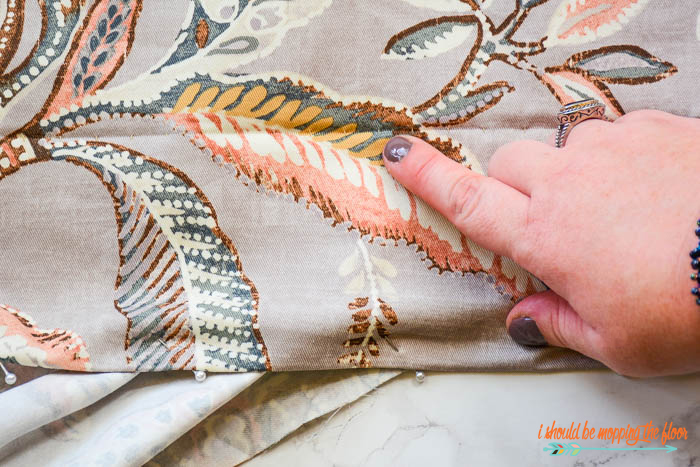This post for how to sew drapes contains affiliate links. I make a small portion when these links are used, at no additional cost to you.
This tutorial for how to sew drapes that are reversible is a practical solution for changing out your drapes seasonally. It also creates a really lovely look for your window treatments from the outside of your home. Check out my method for how to sew drapes that are reversible below.
I shared our master bedroom here a couple of weeks ago...but I just gave it a pretty significant update with these floral reversible drapes I created for this space. I made them reversible for several reasons...but honestly, now I want reversible drapes in all of our rooms. Check out this complete tutorial for how to sew drapes (reversible ones!) below. How to Sew Drapes that are Reversible
The fabric I used on the main side of the draperies in this post is Waverly's Key of Life in Blush (available here on Amazon). I think it almost has a chinoiserie feel to it. The colors are so stunning in the design.
I love how they make the colors in my antique plates really pop, too.
Above is an entirely different look using the reverse sides of the drapery panels. This fabric is called Ballad Bouquet in Platinum from Waverly (it's also available here on Amazon). I think it will be perfect to use in the winter months...it's like the perfect mix of winter whites and grey tones.
These drapes were a bit of a necessity. When we moved into this 1972 fixer over a year ago, I realized the large glass slider door from our bedroom (it's pictured below) into the sunroom left our room pretty exposed to the entire house (including the window to the front door). There was literally a straight view into my bathroom's vanity area from the front door. I bought some cheap drapery panels as a quick fix to at least make the place habitable until I could find the drapes I really wanted. But the cheap ones were just that...cheap. They were thin and sloppy looking. On my side of the bed, our neighbor's light above his garage shown through the drapes all night...which was a bit of a bother for me. Since it was a security light, I didn't want him to have to alter his routine. But, I knew we needed something a lot thicker than those old cheapies. These new reversible drapes are so nice and thick that they act as blackout drapes, too. I don't even see his light anymore.
Supplies for Sewing Drapes that are Reversible:
- For this tutorial, you'll need two heavier fabrics in enough yardage to cover your windows. The fabric I used was twill. Using something too thin may cause the designs to show from the reverse sides. Again, you can purchase these same fabrics below on Amazon (I actually enjoy purchasing fabrics this way and they come right to my door):
- The main design I used was the Key of Life in Blush fabric from Waverly available here on Amazon.
- The grey-toned fabric that I used is called Ballad Bouquet in Platinum (also from Waverly), and also available here on Amazon.
- straight pins: using the kind with larger pearl heads is a good way to go here (you'll actually leave the pins in place while sewing one of the stitches and it makes them easier to see so you don't sew over them)
- coordinating thread (the thread pictured above on the right looks off in color, but it is a taupe that ended up working well with the Key of Life fabric)
- sewing clips: I LOVE these things (life-changing, y'all!) They make the work a bit faster...they're a nice alternative to pins.
- sewing scissors
- a blind hem presser foot for your sewing machine (these come standard with most machines)
As I mentioned, I cut my fabric at 96" lengths. You'll need one of each of your fabric patterns for each panel. So, each of my panels has two pieces of fabric, both cut at 96"x54". If you have tiled floor, it's easy to cut large fabric panels on that. We have 12" tiles, so it makes it fairly easy for projects like these.
Sewing a Blind Hem Stitch
On one of your SHORT sides of each piece of fabric, you're going to be doing a blind hem stitch. This will be at the bottom of your drapes. It's a nice stitch that is kind of hidden and makes for a super clean look. You'll do one of these stitches on each of your fabrics on one of the shorter sides. Then we will sew them together (right sides together, sewn on three sides), and turn it all inside out to make the drapery panel. It's not nearly as complicated as it sounds...pinky promise, y'all!

I have my entire tutorial for sewing a blind hem stitch here. Or, you can see my thorough video below on this stitch. It's a great one to know, y'all...and not nearly as complicated as it may sound.
You may actually want a smaller stitch length than the one I used here (pictured above). I wanted to show you how the blind hem stitch looked, so mine's slightly longer. The best way to get good at this stitch is to practice several times on scrap fabric (and text with your expert sewer mother-in-law, like I did!). This hem is perfect for drapery and trouser projects.
You can remove those pins now. Then iron your fabric really well so this crease we made no longer shows.
Repeat this blind hem stitch on your other piece of cut fabric. Then we will be sandwiching them together to make the reversible drapery panel.
Above is one corner of the sandwich. You will lay your two pieces of fabric for your panels right sides together (or, pretty sides together, like my mother always said when she sewed). If you cut everything correctly, it should all line up. The most important line is the one on the bottom (where you just made those blind hem stitches on each piece of fabric). Make sure those line up perfectly. If you're off a bit on the other areas, it's not too hard to correct with a larger seam or some trimming, but the bottom has to line up perfectly since it won't be sewn together (see below diagram). If your bottom two pieces of fabric do not line up, one will hang longer and show from the opposite side (which kind of gives away your secrets for having reversible drapes). It's all smoke and mirrors, here, y'all. Wink.
The above shows how this all goes together when it's hanging. Leaving the bottom open is a game changer. It makes the drape hang really nicely, even if you aren't the tidiest sewer. If there are discrepancies in your measurements and cuts, it would show really blatantly if all four sides were sewn shut. I learned this nifty trick from my husband's cousin a while back. Again, that blind hem stitch is at the bottom of the drape.
Clip or pin the entire perimeter. Remember, you're not sewing this bottom part, but you want to clip or pin it in place first, so it lines up evenly. Then do the sides and top, too. I had to lay my drape out on my dining table and then the floor to really get it lined up. I did have to trim an inch off of one side of one piece of fabric...it happens.
Do a basic stitch around the three sides you're sewing (remember NOT the bottom!).
I did a big ol' one inch seam on this one...only because I was slightly off on one of my measurements and wanted to be sure I caught both fabrics. You'll want to clip off your two corners that are sewn (but don't cut into your stitching or you'll be super sad).
Turn the entire drape inside out. Push out your corners that you clipped with a sharpish object (I use the slanted side of a wooden manicure stick)...careful not to push all the way through. You just want to push it into a nice, crisp corner.
Press the entire drapery panel...making sure your edges lay nice and crisp for you.
This is a photo of the bottom edge of one of my panels while it was hanging. You can see how I left the bottom open.
I hang my drapes on rings since we open and close them morning and night...they function so well and (to me) look tidier than rod-pocket-style draperies. Plus, this makes them a lot easier to sew than if you were to add in a rod pocket.
In the above photo, I have the Ballad Bouquet side of the drape facing the room...but it's a nice shot to show the reversibility and how well these drapes work. And hey...either way, my neighbor sees a pretty side of the drape, too...no more ugly drapes facing outward, y'all!

Here is the opposite side of the room, where our sliding glass door to the sunroom is. It's so nice to have pretty drapes going both towards the sunroom AND facing into our bedroom, too. You can see that my drapes hang about one inch off the floor. That's actually purposeful, y'all. Here in our part of Texas, lizards and geckos run rampant...and scare the heehaw out of me. They tended to hide in my drapes' puddles of fabric at the bottom (especially here at the sliding door). By keeping these off the floor just slightly, I'm hoping this will keep those away...for the sheer reason that they scare me.
Looking for More Tutorials on How to Sew Drapes?
- My simple, pom pom-trimmed drapes were made from two tablecloths from Walmart...and they're super cute, y'all!
- Within my Blind Hem Stitch Post, I shared some simple summery drapes I made using that same stitch.
- These Bright and Cheery Ruffled Curtains from Bev at Flamingo Toes are just darling (like Bev!).
- These DIY Lined Drapes from Jamie Scattered Thoughts of a Crafty Mom are really useful.



























This is a fabulous idea! We will be moving in a new home soon and I think this would work so well for my new windows. Thank you. Your fabric is beautiful.
ReplyDeleteThank you so much! I appreciate that! xoxo
DeleteIt is a great idea but what about the sun fading the fabric?
ReplyDeleteHi Gail-- This side of our home is full of trees and pretty shaded (it looks brighter in the photo with the way I had to edit the coloring of the photos since I was shooting into the light). I also have narrow windows here...if the drapes are pulled all the way open (they're only pulled halfway for photos), they're over the wall, not the window. I keep them open all day long, so they're really never exposed to direct sunlight. Hope that makes sense!
DeleteThey are absolutely fabulous! You are so talented!
ReplyDeleteLovely drapes and great tutorial! Good job Kristi!
ReplyDeleteThank you so much, Nyla! I appreciate all of the text help along the way! xoxo
DeleteVery pretty! I have the same question as Gail - What about fading from the sun? Won't the side facing the window fade?
ReplyDeleteThanks so much. Yes, this side of our home is full of trees and pretty shaded (it looks brighter in the photo with the way I had to edit the coloring of the photos since I was shooting into the light). I also have narrow windows here...if the drapes are pulled all the way open, they're over the wall, not the window. I keep them open all day long, so they're really never exposed to direct sunlight. Hope that makes sense!
DeleteI love the grey toned side!!! And I feel your pain with lizards coming in the house...that's why I have dogs. ;) Beautiful drapes, Kristi!
ReplyDeletedid you put any interfacing or anything in between to help block seeing the one pattern on the other side?
ReplyDeleteHi there! I chose a twill fabric which is a bit thicker so the patterns didn't show through to the opposite sides. If you use something thinner, interfacing would be a good idea! Great question! Thank you bunches for stopping by!
DeleteHi, thanks for this. I'm not sure when I get the rail up and they're hung, exactly what length I want, no geckos here! It's a door curtain, where there's no room for a door . I'm impressed you got so much done in a year! I'm nearly a year in, and not a great deal appears to have changed so far. I've got the rest of my life , so hey!
ReplyDelete